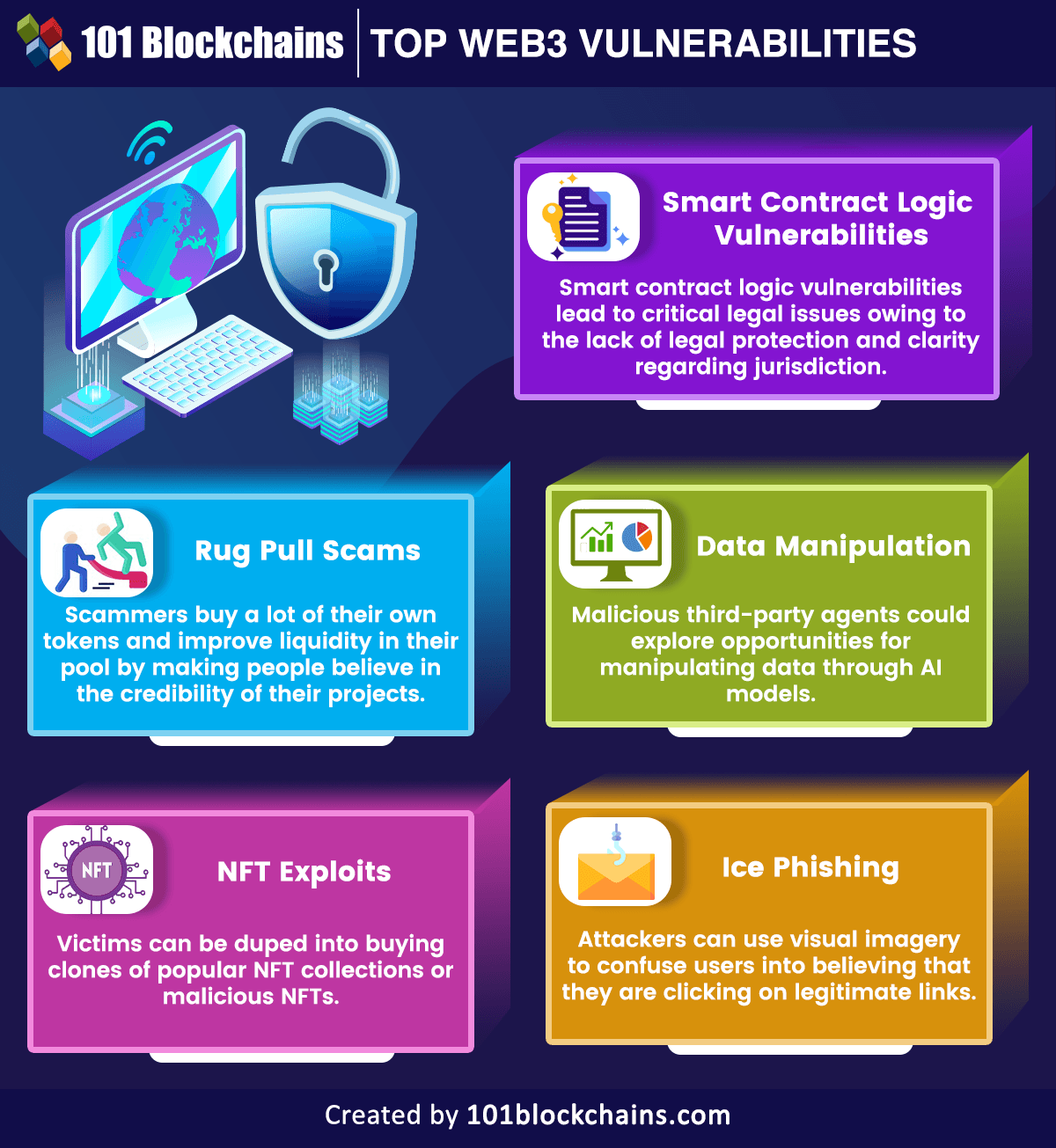Learn how blockchain truly works, master key definitions, and uncover what makes smart contracts so "smart." Dive into the fundamentals, gain valuable insights, and start your blockchain journey today!

- Web3
Georgia Weston
- on April 25, 2023
Top 5 Web3 Vulnerabilities: Know The Challenges And Solution
The Web3 market encompasses blockchain, NFTs, DeFi, metaverse, play-to-earn games, and many other decentralized solutions. Every discussion in the world of technology right now involves references to Web3 and its capabilities. At the same time, the top Web3 vulnerabilities have also been grabbing headlines worldwide for the right reasons. Web3 has become one of the most used words in the tech landscape, and Google searches for the term prove the same.
It provides an innovative and user-friendly way to transform the experience of users with online services and solutions. The answers to “Is Web3 vulnerable?” draw the limelight towards the advantages it brings to the tech landscape. There is no way to deny that Web3 has the potential to transform online experiences with decentralization and through empowering users.
On the other hand, Web3 security risks have also been rising in terms of their economic impact. Apparently, more than 167 major attacks in the domain of Web3 in 2022 resulted in approximate losses of almost $3.6 billion. Within the first half of 2022, Web3 security hacks resulted in losses worth over $2 billion, which is more than all losses in 2021. Therefore, awareness regarding crucial vulnerabilities in Web3 security is an essential requirement for Web3 developers and founders. The following post provides you with a brief guide to challenges with prominent Web3 vulnerabilities and their solutions.
Fundamentals of Web3
Web3 is an innovative transformation in the basic structure of the web with new solutions based on blockchain technology. Experts describe Web3 as the decentralized internet, which can be developed over decentralized blockchains used in cryptocurrency networks, such as Ether and Bitcoin.
The type of vulnerability in Web3 is one of the prominent concerns, considering the fact that websites and apps in Web3 can manage data in intuitive ways, just like humans. In addition, Web3 would not rely on blockchain technology only. The other technologies associated with Web3 include machine learning, distributed ledger technology or DLT, and big data.
Web3 envisions an open, intelligent, and autonomous internet. One of the significant highlights in favor of Web3 points to the assurance of user control. Web3 ensures users have complete control over their data, digital assets, and digital identities.
Learn the fundamentals, challenges and use cases of Web3.0 blockchain from the E-book: An Introduction To Web 3.0 Blockchain
Why Do You Need to Know the Web3 Vulnerabilities?
The need for learning about Web3 vulnerabilities has been gaining prominent levels of attention in recent times. Common responses to ‘what is a vulnerability in security’ would refer to potential areas of attack. In the case of Web3, the prominent highlights focus on the improvements introduced by Web3. On the other hand, it is important to understand how Web3 provides security. At the same time, you should also focus on learning about the notable security threats which have not been addressed in the existing Web3 architecture.
Developments in the Web3 space are continuously expanding, especially in the case of metaverse and NFT collections. However, it is also important to wonder how Web3 presents better security than Web3. The doubts regarding types of security vulnerabilities in Web3 emerge from the threats to Web3 projects.
For example, an attack on the Wormhole Bridge resulted in losses worth over $360 million. Apparently, a hacker had exploited a vulnerability in the design of the smart contract function of the bridge to the Solana blockchain. Therefore, awareness regarding Web3 vulnerabilities is an essential requirement for improving trust in the Web3 ecosystem.
What are Web3 Vulnerabilities?
Before identifying the most noticeable vulnerabilities in Web3 projects, you need to understand the definition of vulnerabilities. The problem with vulnerability in cyber security for Web3 solutions is the complicated nature of vulnerabilities. Web3 projects have led to an unprecedented rise in the number of security issues. The biggest problem in ensuring Web3 security focuses on the issue of obtaining the help of specialists. While bug bounty programs serve effective results in the identification of Web3 vulnerabilities, many cybersecurity professionals dismiss Web3 and blockchain as scams.
Web3 vulnerabilities are gradually becoming troublesome concerns for Web3 projects. The number of Web3 applications based on blockchain technology continues to rise and increases the surface area for hackers. As a matter of fact, Web3 security risks feature similarities to conventional cybersecurity issues. Permissionless environments and possibilities of bugs in smart contract code present favorable factors for compromises in smart contract functionalities. Therefore, it is important to review the most impactful Web3 vulnerabilities, their challenges, and the relevant solutions.
Build your identity as a certified blockchain expert with 101 Blockchains’ Blockchain Certifications designed to provide enhanced career prospects.
Most Popular Web3 Vulnerabilities
A detailed understanding of responses to ‘what is a vulnerability in cyber security’ would help you identify the conventional problems for cybersecurity. On the other hand, the potential similarities between Web3 vulnerabilities and traditional security risks provide better flexibility for understanding the security risks in Web3. Here is an outline of the most prominent Web3 vulnerabilities you should watch out for in 2023.

Please include attribution to 101blockchains.com with this graphic. <a href='https://101blockchains.com/blockchain-infographics/'> <img src='https://101blockchains.com/wp-content/uploads/2023/04/Top-Web3-Vulnerabilities-1.png' alt='Top Web3 Vulnerabilities='0' /> </a>
Curious to develop an in-depth understanding of web3 application architecture? Enroll Now in Web3 Application Development Course!
Smart Contract Logic Vulnerabilities
The use cases of smart contracts in Web3 have opened up the roads for creating many innovative applications. At the same time, smart contracts have emerged as one of the top Web3 vulnerabilities owing to faults in the application logic. Smart contracts define the specifications of an agreement in a contract with code and work according to the defined logic.
-
Challenges with Smart Contracts
The problem with smart contracts is that they have to be deployed on a blockchain network for desired operations. The presence of smart contracts on decentralized blockchain networks implies that the security of smart contract data depends on the security of the underlying blockchain.
The types of security vulnerabilities in smart contracts emerge from the issues in the logic of the smart contracts. Logic hacks on smart contracts have been implemented for exploiting various features and services in Web3 projects. On top of it, smart contract logic vulnerabilities can also lead to critical legal issues owing to the lack of legal protection and clarity regarding jurisdiction.
-
Solutions for Smart Contract Vulnerabilities
The solutions for addressing vulnerabilities with smart contracts would revolve around careful evaluation of the nature of blockchain and smart contracts. Careful evaluation of the blockchain and smart contracts throughout different stages, from planning to the testing phase, can help in reviewing all blockchain traits. You can address smart contract vulnerabilities and the associated Web3 security risks by learning about blockchain and smart contract programming.
Excited to learn about the critical vulnerabilities and security risks in smart contract development, Enroll now in the Smart Contracts Security Course!
Rug Pull Scams
Another prominent addition among vulnerabilities in the Web3 landscape refers to rug pull scams. Rug pulls scams refer to events in which malicious Web3 developers abandon a project after gaining access to massive chunks of investor wealth. The definition of rug pull vulnerability in cyber security is similar to Ponzi schemes in the real world. A group of developers created a Web3 project and a native token that is listed on decentralized exchanges in pair with popular cryptocurrencies such as Ethereum.
-
Challenges with Rug Pull Scams
The most prominent challenge with rug pull scams is the fact that you don’t get a whiff of foul play before it is late. Rug pulls scammers to start by creating hype around their project on Twitter, Telegram, and different social media platforms. Some rug-pull scams also hire influencers to make people believe in the credibility of the project.
In addition, the scammers buy a lot of their own tokens and improve liquidity in their pool, thereby earning the faith of investors. The problem with such a type of vulnerability in Web3 becomes more complicated with the ease of listing tokens without any costs on decentralized exchanges.
-
Solutions for Rug Pull Scams
The recommended solution for avoiding losses due to rug pull scams is due diligence. You must invest efforts in comprehensive research about a Web3 project before investing your money in it. Starting from the token pool to the details of the founders and roadmap of the project, you need to review different aspects of Web3 projects to avoid the risks of rug pull scams.
Excited to learn the basic and advanced concepts of ethereum technology? Enroll Now in The Complete Ethereum Technology Course
NFT Exploits
NFTs or non-fungible tokens are also other common targets of Web3 security threats. Non-fungible tokens play a crucial role in driving the mainstream adoption of cryptocurrencies and encouraging the acceptance of Web3. NFTs can serve multiple use cases other than defining unique proofs of asset ownership.
-
Challenges with NFT Security
The responses to “Is Web3 vulnerable?” with respect to NFTs would also focus on smart contracts, which define the ownership record of NFTs. Non-fungible tokens are a comparatively new technology, thereby implying the necessity for familiarizing themselves with challenges to their security. For example, victims can be duped into buying clones of popular NFT collections or malicious NFTs. Only one click on a link for a malicious NFT can grant complete access to your NFT collection or crypto assets.
-
Solutions for NFT Security
The identification of vulnerability in cyber security for non-fungible tokens does not suggest that you should not use NFTs. On the contrary, you need to look for better solutions that can help you develop a comprehensive understanding of vulnerabilities in NFT smart contracts. Furthermore, you can also leverage alerts and notifications for suspicious activities in NFT marketplaces to avoid security risks.
Data Manipulation
Another prominent concern in Web3 security points to the possibilities of data manipulation in dApps, which are a vital component of the Web3 landscape. Decentralized applications rely on peer-to-peer networks and distributed codebase, which helps in storing data.
-
Challenges of Data Manipulation
AI is one of the vital technologies in the Web3 landscape, and you can find many dApps and smart contracts using artificial intelligence. The AI models need large amounts of high-quality data for training on a particular topic. Without adequate safeguards for dApps or smart contracts, malicious third-party agents could explore opportunities for manipulating data through AI models.
-
Solution for Data Manipulation
The solutions for Web3 security risks with data manipulation point at the selection of secure blockchains for deploying dApps.
Start your journey to becoming an expert in Web3 security skills with the guidance of industry experts through Web3 Security Expert Career Path
Ice Phishing
The list of prominent Web3 security vulnerabilities also includes ice phishing as a recent addition. It focuses on the use of deceptive techniques for duping users into signing malicious transactions, which grant permissions to the attackers to utilize the user’s tokens. The origins of ice phishing emerge from the facility of delegation of token usage permissions.
-
Challenges in Ice Phishing
Ice Phishing techniques are one of the most dangerous types of security vulnerabilities in Web3 as they focus on social engineering attacks. Attackers can use visual imagery to confuse users into believing that they are clicking on legitimate links.
-
Solutions to Ice Phishing
The solution to ice phishing points to the necessity of security training. Web3 users must follow the best practices for interacting with emails and double-check before clicking on links. You should pay attention to the logos, website URL, and project name carefully to avoid issues of ice phishing.
Conclusion
The outline of the notable vulnerabilities in Web3 proves that Web3 is not as secure as everyone imagined. It is a new technological concept and has its fair share of setbacks in security. Most important of all, the top Web3 vulnerabilities focus on identifying areas of attack that can generate convenient results for attackers. For example, a simple error in the smart contract code can lead to losses of millions of dollars. Therefore, research on Web3 vulnerabilities would be a vital requirement for supporting the adoption of Web3 in the future.
*Disclaimer: The article should not be taken as, and is not intended to provide any investment advice. Claims made in this article do not constitute investment advice and should not be taken as such. 101 Blockchains shall not be responsible for any loss sustained by any person who relies on this article. Do your own research!







